How to choose a dry closet for a summer residence: tips for choosing and an overview of the best models
The lack of a traditional bathroom in the summer cottage is a serious inconvenience that can significantly overshadow the charm of suburban life. But this problem can now be very easily resolved.
Even if there is no place or desire for the construction of a house with a cesspool, it is enough to purchase a dry closet. But how to decide on the most suitable model? Agree, the details should be found out before the purchase.
The article presented by us explains in detail how to choose a dry closet for a summer residence, introduces existing varieties, and highlights the features of operation. Focusing on reliable information, you will not be mistaken in your purchase, but will get the perfect option for you.
We have described in detail the design features of the models, the specifics of their placement and the principle of processing the contents. A brief overview of the marketable dry closets from leading domestic and foreign manufacturers is given. The information is supported by a useful selection of photos and videos.
The content of the article:
Types of dry closets for a summer residence
Dry closet is an effective alternative to stationary plumbing. He does not need a connection to the sewer and water supply. Utilization of human waste products in it occurs due to natural or chemical substances.
The compactness of this device allows you to transport it in a car, using not only at the cottage site, but also just outdoors when holding a picnic or other events outside the city, away from city amenities.
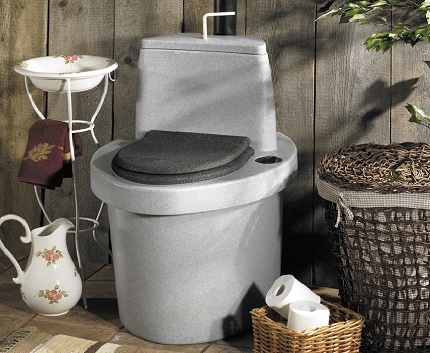
All models of dry closets by the method of waste treatment and the type of active substance are divided into:
- peaty - The main components of the utilization of peat and bacteria in it;
- liquid - use household chemicals;
- electric - excrement processing is carried out thanks to electricity.
Structurally, such plumbing is a classic “night pot”.Only it does not need to be taken out after each use, and the processing of effluents occurs due to special bacteria, chemistry or electricity. In detail about the device, the specifics of work and the rules for using the dry closet, we talked here.
The presence in the design of check valves prevents the spread of inside the toilet amber.
Type # 1 - peat (compost)
From the point of view of correct terminology, a toilet with the prefix “BIO” can be called exactly and exclusively peat models. In them, everything happens on the basis of natural processes.
Peat inside them serves as a kind of sponge, and special bio-bacteria process waste, turning them into compost for beds.
Often such a toilet is called a "powder-closet." This term refers to the powdering (“dusting”) of fecal waste with powdered formulations (ash, peat, sawdust, etc.).
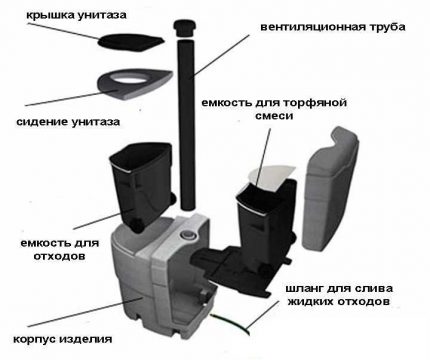
Among the advantages of peat dry closet are:
- the relative cheapness of the plumbing device;
- low cost of consumables based on peat;
- absolute environmental cleanliness due to the lack of the need to add any chemistry;
- the possibility of using the result of processing as fertilizers;
- lack of need for availability on the water supply site.
But before choosing a peat dry closet for your summer residence, you should know that he will not be able to completely get rid of toilet odors. He simply is not capable of this constructively.
It has only one tank in which ripening compost is processed and stored. And no water pumps and check valves. The kit has an exhaust pipe that removes odors, but nothing more.
After a person visits the restroom, the waste due to gravity falls into the lower tank and is poured from above with peat. The filtered and purified liquid is subsequently partially evaporated through the hood. And solid residues remain in place and decay, turning into fertilizing for garden plants.
But here lies the main problem of such a toilet. If ten people come to the country at the same time to rest, then the compact portable version will not be able to cope with the waste of their life.
One must either look for a more capacious stationary model, or organize a partial drainage of liquid effluents into the ground.
The active substance should be used only as recommended by the manufacturer of the specific dry closet. "Peat" peat is produced in the form of granules, powders and compositions with additives (lime, sawdust, coniferous bark, etc.).
And each mixture has its own effectiveness. We recommend that you look at a comparative review of the popular fillers for peat toilets.
On average, 1 kg of pure peat makes it possible to process about 10 kg of excrement.
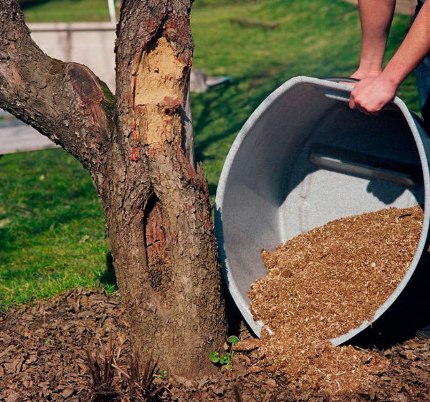
Type # 2 - Liquid (Chemical)
The liquid dry closet is arranged according to a scheme similar to the peat analogue. There is an upper tank and a lower one, each of which has its own liquid. In the upper module, it is deodorizing, washing - to reduce odors and flushing excrement, and in the lower - processing (dissolving).
This version of bio-nitase involves the chemical dissolution of waste, followed by disposal of the resulting liquid.

The composition of liquids for this type of dry closets is divided into three groups:
- Formaldehyde - red, toxic.
- Ammonium - blue, low toxicity.
- Biological (with bioactive bacteria) - green, relatively safe.
Formaldehyde-based compounds can only be drained into a centralized sewage system. Their components are too toxic to allow them to enter the soil of the summer cottage.
Ammonium-based fluids are less harmful, they can already be used as fertilizer for lawn grass or shrubs in hedges. They are not intended for feeding vegetable and fruit crops.
Waste processed by bioactive compounds is quite suitable for fertilizing a country garden. But it is better to leave them for two to three years first for more thorough fermentation in a compost pit. Immediately pour these liquids on the beds or under the apple trees.
With the volume of the upper dry closet capacity of 22–24 L, one liter of formaldehyde composition is enough for 1.5–2 months of use. A liter bottle with ammonium-based concentrate is enough for 2–2.5, and an analogue with bacteria for 3 months.
But formaldehyde and ammonium compounds are approximately equal in cost, and biological ones are 5-6 times more expensive than them.

A liquid dry closet for a summer residence is chosen, as a rule, when a compact device for a child is needed. Such a toilet is transported without problems in a passenger car and quickly goes into working mode.
Installing a stationary liquid model with a large lower tank in the garden is not worth it. With comparable volumes of waste processing, it will have to be emptied more often than a peat toilet. Plus, drainage needs sewage.
The liquids sold for this toilet must be diluted in water in accordance with the instructions. In a bottle they are in a concentrated state, they cannot be used undiluted.

Type # 3 - Electric (Volatile)
Visually, the dry closet with the electrolysis of excrement is similar to liquid. However, the processing processes in them are fundamentally different.
In electric models, the liquid must be removed from the incoming masses instead of dilution, as in chemical ones. First, excrement is divided into liquid and solid fractions. Liquids are discharged into the cesspool or into the sewer system.
Solid and wet residues are exposed to:
- burning in a sealed chamber;
- or dried with a disinfectant powder.
In both cases, the resulting mass takes up space and weighs quite a bit. Subsequently, it can be used to fertilize green spaces in the country.
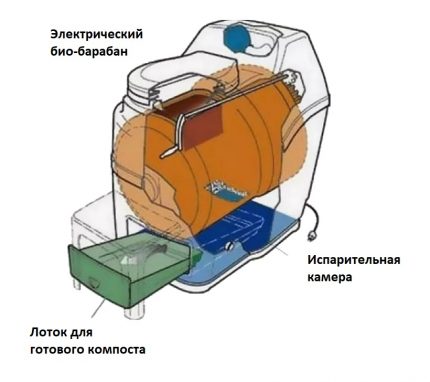
In addition to the high cost and the need for electricity, such models of dry closets have another drawback - they need forced ventilation.
It is not possible to avoid odors when burning or drying feces. Only the presence of a good ventilation system will allow you to get rid of the accumulation of these amber in the bathroom.
Key parameters of the dry closet selection
The principles of operation of the above three types of devices differ, but when choosing a dry closet for a summer residence, there are a number of general parameters that should be taken into account. For starters, you can compare types of dry closets among themselves by key parameters that are important to you.
But the most important thing is to look at its dimensions and capacity, the material of the case and the active substance used. The presence of additional functions and devices relates more to the issue of ease of use of this type of plumbing.

The eight most important options for choosing a dry closet model are:
- The presence or absence of a built-in drive full indicator - not a fundamental, but convenient trifle.
- Dresser Height - 32–34 cm will be most convenient for a child, and for adults it is best to select options with a standard height of 42–46 cm.
- Waste Tank Volume - the big one fills longer, but it is also harder to carry and more difficult to empty.
- Correspondence of the storage volume to the number of users - liquids and peat have a limited period of use, after which they must be replaced (too large a tank will not have time to fill up completely, but it will still have to be replaced in it).
- Pressure valve on the lower tank of the fluid device, which closes the ventilation hole, so that when the tank is transferred from it, the contents are not sprayed in different directions.
- Body material - polypropylene, polypropylene with fiberglass, polyethylene (the latter should be excluded if the dry closet is chosen for use in the country in the winter).
- Installation principle - portable or stationary device.
- Permissible load - from 120 to 400 kg.
For the convenience of carrying and unloading the storage tank, it should have wheels and a reliable handle. Also, before buying, you should pay attention to the specifics maintenance and cleaning of the dry closet - It’s not very pleasant to clean the drive after each use.
And when choosing a specific model, you should focus on the mass of the largest family member. A plastic toilet seat and bio-nitase case must be able to withstand an overweight person, if he is among relatives or guests of the summer residence.
Another important point is the difficulty of installing and connecting a specific model to communications (if this is assumed when using your dry closet). Features of the installation of various toilets we examined in our other article.
A brief overview of manufacturers and models
Before going to the store, you must correctly assess the necessary spaciousness and dimensions of the plumbing in question. If a compact design is required, it is best to opt for a liquid model with a lower capacity of up to 21 liters.
And if you need a more convenient option with longer reboots, then you should take a closer look at the peat analogue with a drive of 100 liters or more.
But what kind of dry closet for a summer residence is better from the point of view of the country of manufacture and manufacturer? The choice here is frankly small.
The country of production does not really matter. Both in Russia and in Europe, this plumbing is produced according to general technologies and standards. You should not buy only frankly cheap products of unknown origin.
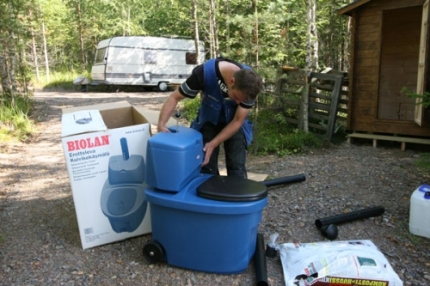
Among the main manufacturers:
- by liquid models - “Thetford” (Netherlands), “BIOFORCE” (China) and “Enviro” (Canada-USA);
- on peat devices - “Kekkila” (Finland), “Piteco” (Russia), “Compact-Eco” (Russia) and “Biolan” (Russia).
- on electrical appliances - “Cinderella” (Norway) and “Separett” (Sweden).
The choice of the right model in the plumbing store largely depends on the needs of the buyer. The assortment range for each represented manufacturer is quite extensive, there are options both portable for transportation by road and stationary for installation in the country on an ongoing basis.
When buying, it is advisable to focus on rating of the best dry closets for summer cottages and private homes and reviews of the owners of the model you like.
The price range of dry closets is wide - from 3000–3500 for a peat model to 80,000–90000 for an electric unit with a heated toilet seat. The service life of these devices in almost all manufacturers is the same - up to 10 years.
By chemistry of the filler, they are stable by definition, rather, they simply break down from old age or mechanical stress.
Do not want to buy a cheap model, and the option you like is quite expensive? In such a situation, you can make a dry closet yourself. And what materials are needed and how to properly assemble it, we described in detail in next article.
Conclusions and useful video on the topic
Interesting and useful videos will help you in choosing a comfortable dry closet for a summer residence or a country house.
Video review of different types of dry closets:
How to make a homemade toilet without odors:
How to choose a convenient portable toilet for a summer residence:
For a summer residence, it is best to select a model of a peat dry closet. It is cheap, compact, extremely easy to operate and produces natural fertilizers for plants in the garden.
Liquid and electric options are more suitable for country houses with permanent residence. But compact chemical dry closets can also be used as a portable closet.
You do not know what model of a dry closet to get for your summer residence? Maybe you still have questions that we did not touch on in this article? Ask them in the comment block below - our expert will try to clarify incomprehensible points.
Or do you already use a dry closet and want to share your impressions of the selected option with other users? Leave comments, add photos of your model, point out significant shortcomings that you have already encountered during operation.

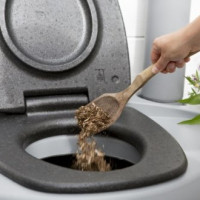 Peat Toilet Fillers: A Comparative Review and Selection Tips
Peat Toilet Fillers: A Comparative Review and Selection Tips 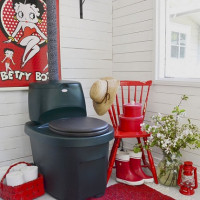 Which dry closet is better: liquid or composting? What to buy: peat or chemical option
Which dry closet is better: liquid or composting? What to buy: peat or chemical option 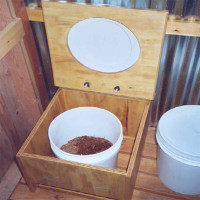 DIY dry closet: a step-by-step guide to the construction of a peat dry closet
DIY dry closet: a step-by-step guide to the construction of a peat dry closet 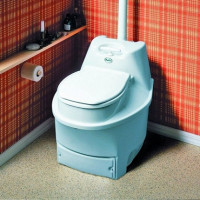 Rating of dry closets for a summer residence and a private house: popular models + recommendations for customers
Rating of dry closets for a summer residence and a private house: popular models + recommendations for customers  How to clean dry closets: features of cleaning peat and liquid varieties of dry closets
How to clean dry closets: features of cleaning peat and liquid varieties of dry closets 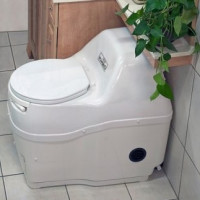 What is a dry closet: the principle of operation and the specifics of using autonomous plumbing
What is a dry closet: the principle of operation and the specifics of using autonomous plumbing  How much does it cost to connect gas to a private house: the price of organizing gas supply
How much does it cost to connect gas to a private house: the price of organizing gas supply  The best washing machines with dryer: model rating and customer tips
The best washing machines with dryer: model rating and customer tips  What is the color temperature of light and the nuances of choosing the temperature of the lamps to suit your needs
What is the color temperature of light and the nuances of choosing the temperature of the lamps to suit your needs  Replacement of a geyser in an apartment: replacement paperwork + basic norms and requirements
Replacement of a geyser in an apartment: replacement paperwork + basic norms and requirements
Husband's parents live in the city, but in the private sector. There is no central heating, water is used from the well, and amenities are in the courtyard. In winter, reluctance to go there, therefore, acquired a chemical dry closet. I do not know the model, but it is very easy to use. To eliminate the unpleasant odor, a blue liquid is used, and there is also a fill indicator that will notify you by a color change that it is time to clean the waste tank.
I see no reason to overpay for a dry closet with a heated toilet seat. The service life is the same, and so, these advantages are not fundamental to me. For a summer residence, for example, we use peat dry closet, then fertilizers will come in handy. And for trips to a picnic with friends, so as not to go to bushes or a public place where a pungent stench eats away our eyes, we take a liquid dry closet.
I think to take a peat dry closet. A friend says that it’s better to take Finnish ones, because Russian have thin plastic and it happens that they burst, especially in the cold. It is embarrassing that this same friend claims that not every peat is well suited, and buying normal is not so simple.
Why is it Finnish, and not even a particular company, but just one country of origin? Is Swedish or Dutch worse if you don’t trust domestic ones?